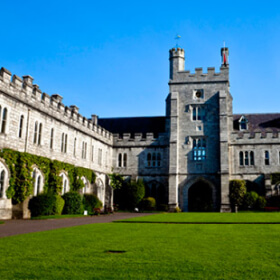Doctoral Research
Two of the Youth Climate Justice team members are not only working on research outputs for the project as a whole, but they are also pursuing exciting PhDs and their own original research at the intersection of children’s rights and youth climate justice. On this page, you will find a summary of each of their research, including updates and achievements throughout the duration of the project.
Liesl Muller
Thesis Title: The state of child participation (CRC Article 12) in youth climate justice litigation
Abstract: Child participation is a principle based on article 12 of the UN Convention on the Rights of the Child (CRC) which contains the child’s right to express their views freely and for those views to be given due weight. This thesis is concerned with climate cases and youth climate action in (South) Africa. It examines the argument that child participation has evolved greatly because of youth climate action, resulting in a postpaternalist time (Daly, 2022) for children's rights where children globally in a grassroots matter are claiming and shaping their own rights. Postpaternalism theorise the impact of child/youth climate action, particularly in South Africa, on the meaning, implementation and interpretation of child participation and Article theorises the impact of child/youth climate action, particularly in South Africa, on the meaning, implementation and interpretation of child participation and articles Article 12 of the UN Convention on the Rights of the Child (CRC), s that that children are now rights leaders, and the CRC must be interpreted or approached differently, with children as partners. This thesis examines this in the context of (South) Africa child/youth climate action. The methodology involves a multimethod approach, primarily legal analysis of climate cases, and workshops with young climate advocates in South Africa. The thesis examines what the impact of child/youth climate action, particularly in South Africa, has on the meaning, implementation and interpretation of child participation and article 12.
Research Outputs & Articles
- Youth Climate Justice Case Law Database, available here!
- Aoife Daly, Nabin Maharjan, Esther Montesinos Calvo-Fernández, Liesl Heila Muller, Emily Margaret Murray, Alicia O’Sullivan, Florencia Paz Landeira, and Katie Reid. "Climate Action and the UNCRC: A ‘Postpaternalist’ World Where Children Claim Their Own Rights." Youth 4, no. 4 (2024): 1387-1404. https://doi.org/10.3390/youth4040088
- Aoife Daly and Liesl Muller. "Child/Youth Climate Litigation: Tracking Children’s Rights and Children’s Impact." Washington and Lee Law Review 82, no. 3 (2025): 1049. Available at https://scholarlycommons.law.wlu.edu/wlulr/vol82/iss3/7/.
- Liesl Muller, “Children at the Lekgotla: African Child-led Remedies for the Climate Crisis,” African Journal of Climate Law and Justice 1, (2025): 59-92. https://ajclj.up.ac.za/muller-lh
Conference Papers/Abstracts
Environmental Lawyers Association of South Africa Annual Conference (9 – 10 October 2025) Thoyandou, South Africa
Title: Children speaking in turn: Redefining legal duties through child & youth climate litigation
Abstract: Children and youth globally are establishing themselves as legitimate political actors in the environmental justice arena. Through their climate action, including litigation, they force governments to engage them as equal citizens who deserve action on their rights now, as opposed to in future, as adults. In South Africa, cases like Cancel Coal – a case brought by a youth-led alliance opposing new coal power – confirm that high-level, economically crucial governmental decisions can be overturned on the sole basis that children were neither consulted nor considered in the assessment leading up to the decision. In other child-involved cases in South Africa, courts are having to reinterpret the legal duties of states and private actors in relation to environmental harm, because of its effect on children (see the cases Deadly Air and Children of Kabwe). These developments in the law as a result of children’s – and child-involved – litigation mean that the current scope of environmental impact assessments (EIAs) applied in the course of environmental decisions which affect children (arguably all), no longer meets constitutional standards, and must be redesigned to include what the Committee on the Rights of the Child calls a child rights impact assessment (CRIA). Children’s effect on the content and scope of the law and its meaning for transformative environmental constitutionalism (Murcott, 2022) is a manifestation of what is being theorised as a postpaternalist era of children’s rights (Daly et al, 2024). The presentation will shed light on the phenomenon and detail the legal implications of the cases on future implementation of EIAs, the interpretation of section 24 of the Constitution, and environmental and climate decision-making in South Africa in general.
Emily Murray
Thesis title: Youth Climate Activism and International Human Rights Law: Challenging Paternalism and Reimagining the Human/Nature Relationship
Abstract: Children and youth are at the forefront of the global climate justice movement, exercising political and participatory rights on an unprecedented scale.1 Yet, within children’s rights scholarship, their role and position within the climate crisis is still predominantly framed through narratives of vulnerability and protection, rather than agency and influence. While children and youth are increasingly engaging in climate litigation and participating in international and domestic policy fora, there remains limited research on how these actions are influencing and reshaping the normative foundations of international human rights law—participating in relation to the evolving understanding of children’s rights and the human/nature relationship. Thus, the overarching research question for this PhD research is, ‘How does children and young people’s participation in the global climate justice movement challenge paternalistic conceptions of children’s rights and contribute to a reconceptualisation of human rights and the human/nature relationship?’ which will be examined more specifically through children’s right to health and children’s right to a healthy environment. The research will be situated within the evolving ‘postpaternalism’ theory proposed by Aoife Daly which hypothesizes that children’s rights has entered into a new era, influenced by child/youth climate action, where children and young people are surpassing the traditional ‘vulnerable’ and ‘victim’ narrative and engaging in human rights and environmental work to protect themselves—rather than waiting for adults to give them permission and create spaces for participation.2 Further, this research will examine the relational approaches children/youth are taking, and how this can be conceptualised a part of the wider movement in sustainability research that challenges the status quo and adopts new ways of thinking about the human/nature relationship in law.
Research Outputs
- Aoife Daly, Nabin Maharjan, Esther Montesinos Calvo-Fernández, Liesl Heila Muller, Emily Margaret Murray, Alicia O’Sullivan, Florencia Paz Landeira, and Katie Reid. "Climate Action and the UNCRC: A ‘Postpaternalist’ World Where Children Claim Their Own Rights." Youth 4, no. 4 (2024): 1387-1404. https://doi.org/10.3390/youth4040088
- Aoife Daly, Niamh Purcell, Esther Montesinos Calvo-Fernández, and Emily Margaret Murray. "Participation and Postpaternalism: Child/Youth Climate Action and the UN Convention on the Rights of the Child." International Journal of Children's Rights, no. 33 (2025): 562-593.
Conference Papers/Abstracts
11th CREAN PhD Symposium (16-17 October 2025), Leiden University
Title: Redefining Article 24 of the UNCRC: Children’s Right to Health and Young Climate Activism
Abstract: Since its conception, children’s right to health as enshrined in the UNCRC and other international human rights treaties, has focused on the healthcare setting and children’s agency. Children’s health has been conceptualised from a Western biomedical lens that focuses on the treatment of illness and access to appropriate medications, vaccinations and health services. While these are vital aspects of children’s health, the normative framework of children’s right to health largely ignores the importance of environmental determinants and healthy ecosystems. The triple planetary crisis, however, exposes the urgent need to rethink and redefine the scope of children’s right to health to include environmental and ecological dimensions—beyond considering the “dangers and risks of environmental pollution” (Article 24, UNCRC).
Climate change, biodiversity loss and pollution disproportionately affect children, especially their health, threatening their physical and mental well-being, their survival and their future. In the era of worsening environmental degradation, it is key that children’s right to health is reinterpreted through a holistic, interconnected lens and that state responsibilities go beyond access to healthcare to also include obligations that ensure a healthy environment and stable climate. In response to the impact of the triple planetary crisis, the global child/youth climate justice movement has emerged which is reshaping how we understand children’s health, justice and intergenerational rights. One avenue of this movement is through accessing courts where children and youth are advocating for stronger climate action and environmental protection, often drawing on scientific evidence and the negative impacts on their health and well-being. This paper argues that children’s right to health must also include environmental determinants, and how the child/youth-led climate movement is expanding the normative boundaries of what it means for children to enjoy the right to health.
Southampton University Workshop on the Right to a Clean, Healthy, and Sustainable Environment Across Regions: Implementation, Enforcement, and Future Directions (24-25 April 2025), Hybrid
Title: Children’s relational approach to the right to a healthy environment
Abstract: Over the past decade, children and young people have come to the forefront of the fight for the human right to a clean, healthy and sustainable environment. Through strategic litigation, young plaintiffs around the world are claiming their right to a healthy environment by drawing on principles such as the best interests of the child and intergenerational equity to challenge governments and State actors for their weak climate policies and/or involvement in harmful environmental activities. As the domestic and international courts grapple with the influx of climate cases that aim to implement more ambitious climate action policies, there is something unique about the cases brought forward by children and young people. Perhaps due to their closeness with nature and more relational understanding of the world around them, this paper will argue that children and young people are taking a relational, eco-centric approach when utilising the right to a healthy environment in their climate justice. Even though international human rights law is built upon anthropocentric, individualistic ideologies that separate humans from the natural environment, young plaintiffs are drawing on their relationships and ‘oneness’ with the natural world to demonstrate how inseparable their rights and the environment are. Rather than using a human rights-based approach to claim their ‘entitlement’ to a healthy environment, young plaintiffs are shifting away from such anthropocentric ‘rights’ language towards a more holistic, interconnected understanding of environmental rights. Drawing on biophilia and relational theory, this paper will argue that children’s relationship with the natural environment is transforming the legal understanding of what it means to have a right to a healthy environment.


